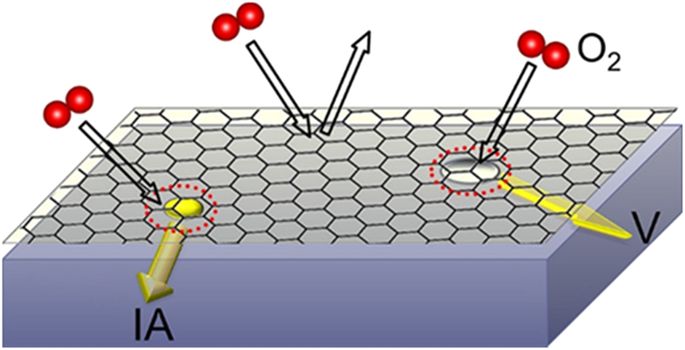npj 2D Materials and Applications ( IF 9.1 ) Pub Date : 2018-01-17 , DOI: 10.1038/s41699-017-0046-y Na Guo , Kah Meng Yam , Chun Zhang

|
Graphene-based solid-state catalysis is an emerging direction in research on graphene, which opens new opportunities in graphene applications and thus has attracted enormous interests recently. A central issue in graphene-based catalysis is the lack of an effective yet practical way to activate the chemically inert graphene, which is largely due to the difficulties in the direct treatment of graphene (such as doping transition metal elements and introducing particular type of vacancies). Here we report a way to overcome these difficulties by promoting the reactivity and catalytic activity of graphene via substrate engineering. With thorough first-principles investigations, we demonstrate that when introduce a defect, either a substitutional impurity atom (e.g. Au, Cu, Ag, Zn) or a single vacancy, in the underlying Ru (0001) substrate, the reactivity of the supported graphene can be greatly enhanced, resulting in the chemical adsorption of O2 molecules on graphene. The origin of the O2 chemical adsorption is found to be the impurity- or vacancy-induced significant charge transfer from the graphene–Ru (0001) contact region to the 2π* orbital of the O2 molecule. We then further show that the charge transfer also leads to high catalytic activity of graphene for chemical reaction of CO oxidation. According to our calculations, the catalyzed CO oxidation takes place in Eley-Rideal (ER) mechanism with low reaction barriers (around 0.5 eV), suggesting that the substrate engineering is an effective way to turn the supported graphene into an excellent catalyst that has potential for large-scale industrial applications.
中文翻译:

石墨烯反应性的基质工程:针对高性能石墨烯基催化剂
基于石墨烯的固态催化是石墨烯研究的一个新兴方向,这为石墨烯的应用开辟了新的机遇,因此近年来引起了极大的兴趣。基于石墨烯的催化中的一个主要问题是缺乏激活化学惰性石墨烯的有效而实用的方法,这主要是由于直接处理石墨烯(例如掺杂过渡金属元素和引入特定类型的空位)存在困难)。在这里我们报告了一种通过底物工程促进石墨烯的反应性和催化活性来克服这些困难的方法。通过彻底的第一性原理研究,我们证明了在下面的Ru(0001)衬底中引入缺陷时,要么是取代杂质原子(例如Au,Cu,Ag,Zn),要么是单个空位,石墨烯上有2个分子。发现O 2化学吸附的起源是杂质或空位引起的显着电荷从石墨烯-Ru(0001)接触区到O 2分子的2π*轨道的转移。然后,我们进一步表明,电荷转移还导致石墨烯对CO氧化的化学反应具有较高的催化活性。根据我们的计算,催化的CO氧化反应是通过Eley-Rideal(ER)机理进行的,该方法具有较低的反应势垒(约0.5 eV),这表明底物工程是将负载的石墨烯转变为具有潜力的优良催化剂的有效方法。适用于大规模工业应用。











































 京公网安备 11010802027423号
京公网安备 11010802027423号